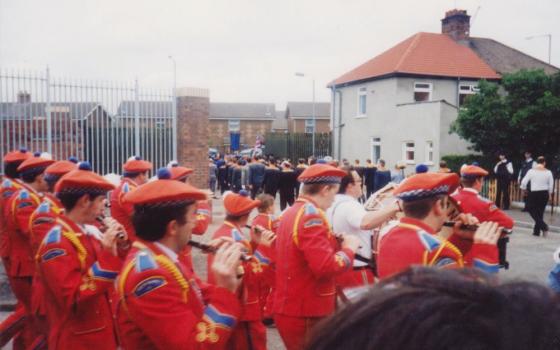Belfast is now home to a vibrant branch of the Irish School of Ecumenics (ISE), long associated with Trinity College Dublin. The Northern Ireland branch is headed by Dominican Sr. Geraldine Marie Smyth, who is involved in research and action on conflict transformation and ecumenical and interreligious reconciliation. It was she who welcomed us on a wet and windy Saturday in February to the gracious house now occupied by the ISE in the shadow of Cave Hill. We were an assorted group of women religious, invited to come together to pool our individual and collective experiences of “The Troubles,” as the conflict in Northern Ireland is commonly called.
This gathering is part of a larger research project undertaken by Smyth, Professor Lisa Isherwood from Winchester University , a well-known feminist and liberation theologian and author, and Dr. Dianne Kirby, reader in American studies at the University of Ulster. The goal is to utilize witness testimony of women, whose voices are often marginalized, to augment academic data in order to provide a more comprehensive understanding of the conflict. They recognized that nationalism and Christianity have placed conflicting demands upon women in their respective communities. They also wanted to explore whether healing and reconciliation could take place through the sharing of experiences.
Almost 40 years of conflict in the province, with an even longer historical build-up, could be expected to have marked people and communities deeply. A research question had been circulated before our meeting: Were women torn between the expectations of their local churches and those of the paramilitaries within their own communities? Thus it was the responses of women which were to be explored. It may have been assumed that sisters might be willing and able to lead the re-visiting of recent traumatic events. The sisters might be an option to start with – maybe?
If this assumption was in the minds of our facilitators, and they had reasonably considered us a homogenous group, they were soon disabused on both counts.
We were welcomed at a lovely pick-up lunch, but even before we left the table, some divergent opinions surfaced amongst us. One sister announced clearly that she had come to listen, not to take part. This alerted the rest of us to the unknowns in the process ahead; and a landslide of observers seemed likely, many deterred perhaps by the film crew who was recording the event. All of us were aware that once our story got “out there” we would lose control over it to some extent; and the potential for hurt and misunderstandings began to trouble us. As Carol Gilligan has suggested, women are more likely than men to worry about consequences; and the consequences of The Troubles are notoriously long-tailed. Much of the unresolved pain and trauma remains alive; and debate continues about the possible effectiveness or wisdom, of a truth-and-reconciliation-style commission.
However, as we filed into the seminar room, most of us put our trust in our facilitators, themselves all women, and in the flexible methodology they had devised. The initial ice-breaking question they threw out was whether or not we saw ourselves, and other sisters, as risk-takers. From this, the conversation flowed smoothly for over three hours.
By and large the consensus seemed to be that, risks notwithstanding, most sisters just “got on with it,” the work at hand, whether in schools, healthcare, neighbourhood, parish or wherever they happened to find themselves. They were only too well aware of the risks, reminded often by cautions from their own side of the community, from politicians, admonishing threats from paramilitaries, or demands from the Protestant Orange Order regarding proposed controversial marching routes.
Often there was not time to weigh up all the consequences, and many sisters would then go ahead on a “wing and a prayer.” Lacking time for strategies, women functioned instinctively in tense and dangerous situations. Alternatively they might negotiate, or try to, with the source of injunctions coming their way, always bearing in mind safety issues, particularly regarding students or schoolchildren. Sometimes face-to-face encounters arose, through local community groupings, parents, security force personnel, paramilitaries, or maybe contacts within the Orange Order whom they knew.
Sisters found that involving the police, the Royal Ulster Constabulary (RUC) , could be counter-productive, since the police would inevitably be caught in the sectarian middle and thus become ineffective or worse. Because they were backed up by a strong army presence, their impartiality was not trusted by the Nationalist side of the community. The title itself – Royal Ulster Constabulary –heightened the Nationalist (Catholic) perception of them as a “Protestant police force for Protestant people.” Their operational areas were often separated by a Peace Line, and they were unable to encroach on the territory on the other side of it. Consequently when street violence moved rapidly, as it sometimes did, from one side to the other, this made police pursuit ineffective, if not impossible.
It soon emerged that similar or complementary responses to the conflict could not be expected from individual sisters, even from those within the same religious order. All this was influenced by family background and loyalties as well as earlier experiences within the home community in one’s place of origin. Indeed reactions could be diametrically opposed. One sister described radical disagreement between her own attitudes and experience, coming from a rural background, to those of a sister/friend who had come from a small Nationalist enclave in downtown Belfast.
Furthermore, across the province, religious were of diverse ages, professions and even nationalities, with varying years of witness and often a variety of ministry experience from other parts of the world. Hence, we naturally brought very different perspectives and skills to the complex, local dilemmas.
We did however, share one unifying principle: the rejection of violence as a means of conflict resolution.
The clear alternative to violence was seen to be education, promoted in the schools as the only effective means of changing, or leaving behind the unacceptable situations in which people had been raised. This, one sister said she discovered for herself as a girl, through the inspiration of the teaching sisters who stayed the course no matter what. “They did not leave; so now I’m determined not to abandon young people who are disadvantaged.”
The participants observed that having struggled so hard to build and establish their own Catholic schools, the Nationalist community in general could not consider any transition to integrated education. Furthermore such a transition was strongly opposed by the hierarchy and is only now finding limited acceptance. This explains why so few sisters have yet to become involved in the integrated sector. Since the mid-90s one sister present had worked for 10 years as chaplain and part-time teacher at Lagan College – the first integrated school.
Not all religious ministered in Nationalist heartlands; some became involved in interface areas. But alienation was experienced by many who belonged to cross-border congregations/orders. Some recounted that their headquarters were often in Dublin or elsewhere in the Republic of Ireland; and their leadership seemed at times to have little knowledge or sympathy with the northern conflict. Indeed rather than attend meetings in Belfast, at times, southern community leaders might send a delegate. One could be forgiven for thinking that they wished the northern Troubles would just go away, or be resolved by Britain.
In order to offset some of this north-south incomprehension, a local branch of the Conference of Religious of Ireland (CORI) was proposed for Belfast. And in 1993, with inter-congregational support, a local office of CORI was opened. This was appropriately on an interface on Springfield Road, in a rented house which straddled one of the peace lines. Unlike CORI in Dublin, which consisted of congregational leaders only, the Belfast branch was open to all religious, male and female, as individual members. Consequently it had high commitment from rank and file religious of both sexes, the proportionate majority being women.
Thereafter, a sub-group, Religious for Justice and Peace (RJP), met regularly to support initiatives they could undertake in addressing issues regarding justice and its administration, prisoners and other issues that arose. Problems revolved around the contested Orange Order parades, which could cause weeks of tension, before, during and after the marching season. Members of the RJP sometimes attempted to promote communication between the Orange Order and local communities, with or without security forces involvement. But local residents, aggrieved by decisions of the Parades Commission on contested routes or about political interference, were often outraged by further provocative behavior during parades and the disruption of their areas. In such heated exchanges the peace-makers in RJP risked being repulsed and lumped together with the offending marchers!
However we in RJP, did have some legal support and advice in addressing weighty issues of discrimination and injustice, from professional bodies like the Committee for the Administration of Justice. Their gender sub-group supported the initiative of sending a group of Northern Ireland women to the U.N.’s Fourth World Conference on Women in Beijing, 1995. It was felt that women in Northern Ireland were uniquely affected by the Troubles. The trip was a learning experience for the mixed group who went to China, including a sister from RJP. We were a half-Catholic and half -Protestant group and got a crash course in networking and lobbying at a high political level, on issues of equality, development and peace.
At home the RJP members continued to work at cross-community relations and campaigned, usually by letter, but we also had access to locally elected MP’s who commuted to the “mother” parliament in London.
We recalled that support from the U.K. for a solution to Northern Ireland’s Troubles had taken different forms with successive British governments and was at its highest when Dr. Mo Mowlam was Secretary of State for Northern Ireland. In her inimitable fashion, she seemed uniquely to be able to grasp local sensitivities and women in particular, flocked to the many initiatives she supported. She was popular for her friendly and informal style; but this also provoked jealousy and riled some old-style politicians. However, all too soon she was gone, her term of office cut tragically short by cancer. We felt that we had lost a valued ally in this remarkable woman.
As we sister participants drifted away gradually that Saturday evening, we felt that this initial meeting could be built upon as the process expands to examine the place/role of all Northern Ireland women, many of them our friends, neighbors and colleagues.
The effects on women in conflict situations and their response is increasingly becoming of interest in the relatively new discipline of women’s history (her/story). The momentum that this is gaining worldwide also affects the work of the History of Women Religious. Here there is some urgency in relation to Catholic womens’ orders, due to the rapid changes in their religious life since Vatican II. Most of us experience some anxiety about vanishing archives! For myself therefore I was happy to hear of this fledgling Northern Ireland research project by such reputable scholars.
[During nearly 60 years in the Little Company of Mary, Kathleen Keane has traveled extensively, initially as a missionary nurse in southern Africa. She holds a bachelor’s degree in English and psychology and a master’s degree in women’s studies. While living on a peace line in Northern Ireland she studied bioethical aspects of healthcare and gained a master of philosophy degree from Queen’s University, Belfast. Now retired, she lives in a large Dublin community.]

